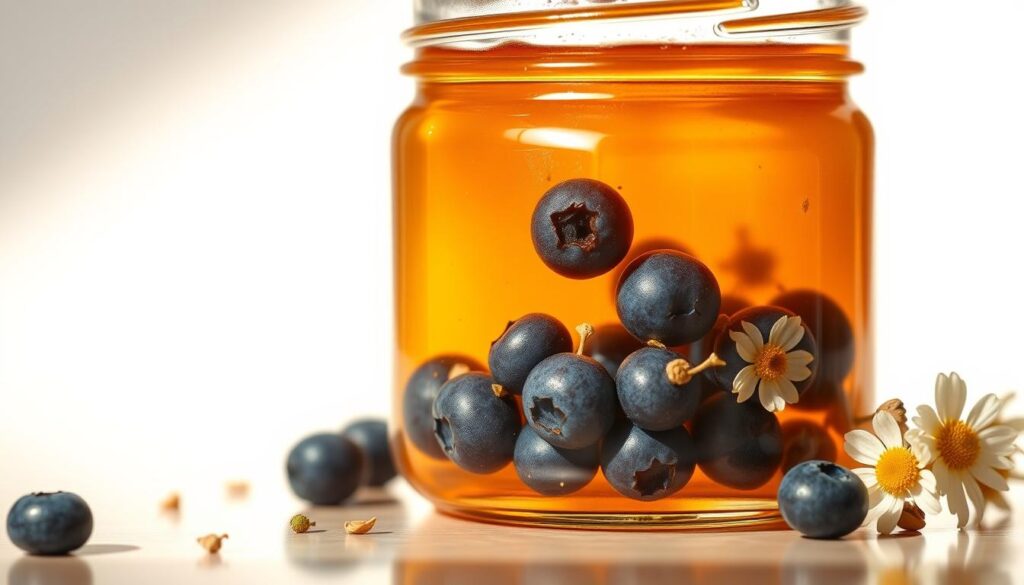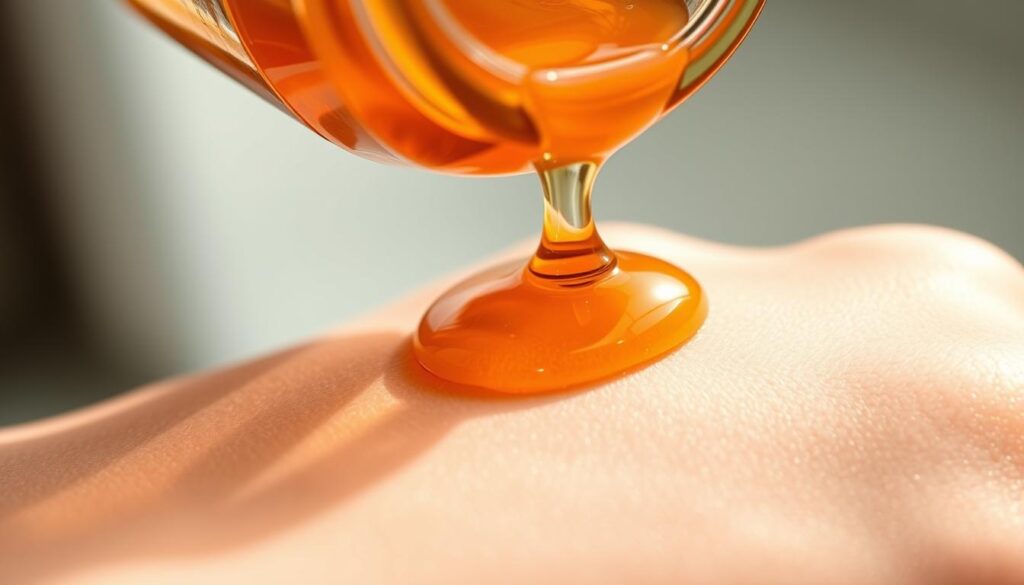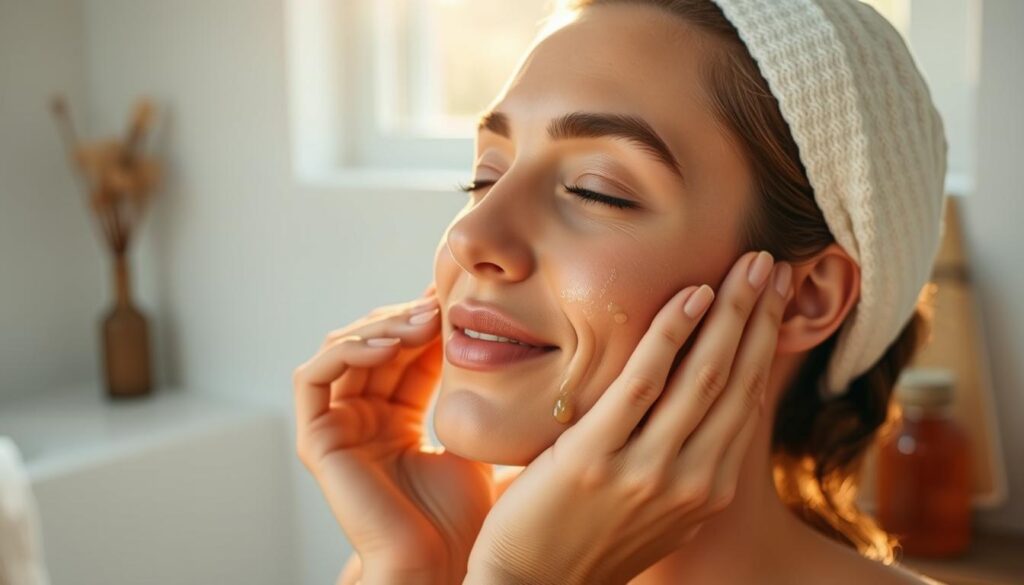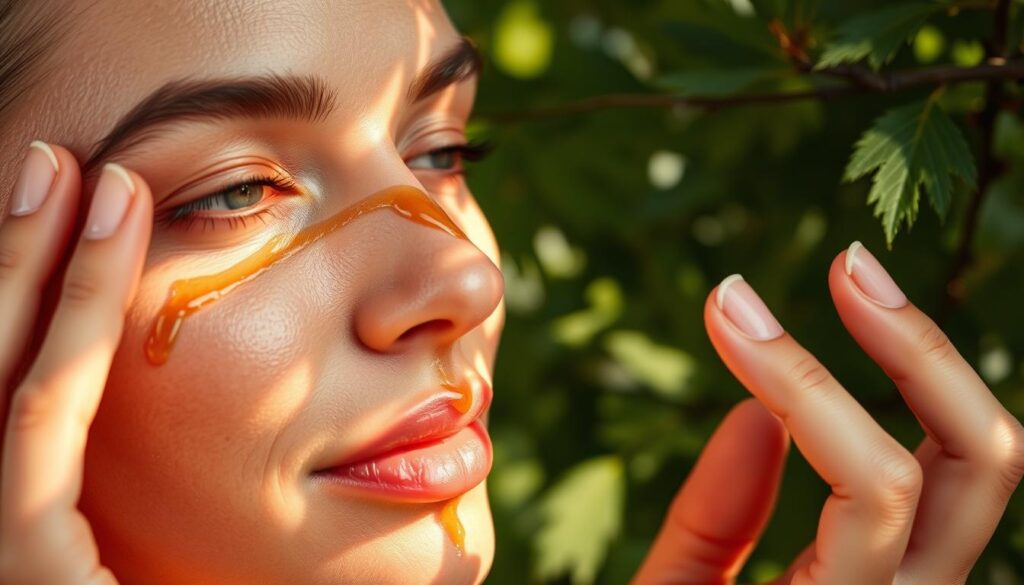Looking for natural skincare ingredients can be like finding a treasure. Maple syrup is a surprising find in the skincare world. It’s packed with nutrients and antioxidants, making it a secret for glowing skin.
Exploring maple syrup’s benefits shows it’s a game-changer for beauty. Both old-school beauty fans and new dermatologists see its value. It fights aging and hydrates deeply, changing how we care for our skin.
Maple syrup comes from maple trees’ sap. It’s full of minerals, vitamins, and antioxidants. Unlike harsh chemicals, it’s pure and helps your skin heal and protect itself.
Experts love natural skincare ingredients, and maple syrup is a top choice. It has many benefits, like keeping skin moist and fighting environmental harm. People looking for a natural skincare solution are turning to maple syrup.
This guide will show you how maple syrup works wonders for your skin. It reduces inflammation and helps cells grow. It’s a natural ally for your beauty routine. Get ready to discover a new way to care for your skin with nature’s sweetest gift.
Understanding Maple Syrup’s Natural Skin Benefits
Maple syrup is more than a tasty breakfast topping. It’s also great for your skin. It has many health benefits that go beyond just eating it.
Natural skincare experts have found that maple syrup is full of nutrients. These nutrients can really improve your skin’s health. It’s a game-changer for understanding how to keep your skin healthy and protected.
Chemical Composition of Maple Syrup
Maple syrup has a lot of good stuff in it:
- It’s full of minerals like zinc, manganese, and calcium
- It has a variety of organic acids
- Its natural sugars can help keep your skin hydrated
Key Nutrients for Skin Health
Maple syrup gives your skin what it needs to stay healthy:
- Zinc: Helps make collagen
- Manganese: Protects your skin from damage
- Antioxidants: Fight off harmful free radicals
Bioactive Compounds in Maple Syrup
Maple syrup has special compounds that are good for your skin. Polyphenols and organic acids work together to protect and rejuvenate your skin. This makes maple syrup a strong natural skincare option.
Nature’s most potent skincare solutions often come from unexpected sources.
The Science Behind Maple Syrup’s Antioxidant Properties
Maple syrup is a natural treasure full of antioxidants. These compounds are key to making our skin look younger. They offer more than just nutrition; they protect our skin in amazing ways.
Studies show that maple syrup has special phenolic compounds. These compounds fight oxidative stress. They shield our skin from damage caused by free radicals, which can make us look older faster.
- Polyphenols protect skin cells from environmental damage
- Reduces inflammation at cellular levels
- Supports natural skin regeneration processes
Maple syrup does more than just clean the surface of our skin. Its antioxidants fight off molecules that harm collagen and elastin. These proteins keep our skin elastic and looking young.
| Antioxidant Compound | Skin Benefit | Concentration Level |
|---|---|---|
| Quebecol | Cellular Protection | High |
| Gallic Acid | Anti-Inflammatory | Medium |
| Catechins | Free Radical Defense | High |
Research shows that these antioxidants can lower oxidative stress. This makes our skin healthier and more durable. Adding maple syrup to our skincare can unlock these benefits.
Maple Syrup Benefits for Skin: Essential Guide
Natural skincare fans are finding out how great maple syrup is for beauty. It’s not just for cooking; it’s packed with benefits for your skin’s health and look.
Maple syrup is a top choice for natural skincare. It’s full of nutrients and compounds that help protect and heal your skin.
Anti-Inflammatory Effects
Maple syrup does more than just hydrate. It also has anti-inflammatory properties that calm irritated skin and lessen redness. The syrup’s polyphenols are strong and can soothe inflammation, making it great for sensitive skin.
- Reduces skin irritation
- Minimizes redness
- Calms sensitive skin conditions
Moisture-Retention Properties
Keeping your skin hydrated is key to its health. Maple syrup acts like a natural humectant, bringing moisture into your skin and keeping it there. Its minerals help strengthen your skin’s barrier, stopping moisture loss and keeping your skin soft.
“Nature’s golden nectar provides more than just sweetness—it’s a skincare powerhouse.” – Dermatological Research Institute
Cell Regeneration Support
Maple syrup is full of nutrients that help repair and grow new skin cells. Its antioxidants protect your skin cells and help them renew. This makes maple syrup a great natural choice for keeping your skin looking young and healthy.
- Protects cellular structure
- Promotes skin healing
- Supports natural skin regeneration
How Maple Syrup Fights Signs of Aging

Maple Syrup for Anti-Aging is a natural way to keep your skin looking young. It’s packed with nutrients that help rejuvenate your skin. This makes it a great addition to your skin care routine.
Maple syrup’s anti-aging benefits come from its antioxidants. These fight off free radicals, which can cause your skin to age too fast. The polyphenols in maple syrup also protect your skin cells from damage.
- Reduces appearance of fine lines
- Supports collagen production
- Enhances skin elasticity
- Provides deep hydration
Studies show that maple syrup has unique compounds that boost cell growth. These compounds improve your skin’s texture and make it look younger. They help your skin renew itself naturally.
| Maple Syrup Component | Anti-Aging Benefit |
|---|---|
| Zinc | Supports skin healing and renewal |
| Manganese | Reduces inflammation and protects skin |
| Antioxidants | Fights free radical damage |
Maple syrup’s ability to hydrate is key to keeping your skin looking young. It helps your skin hold onto moisture. This plumps up your skin, making fine lines less visible and giving you a smoother, brighter look.
Maple Syrup for Natural Skin Brightening
Natural skincare ingredients are changing beauty routines. Maple syrup is now a key player in skin brightening. It gives a radiant, even-toned look without harsh chemicals.
Evening Skin Tone Naturally
Maple syrup brightens skin with its natural compounds. It has:
- Organic acids that gently exfoliate skin
- Antioxidants that reduce uneven pigmentation
- Mineral-rich nutrients supporting skin renewal
Dark Spot Treatment Strategies
Maple syrup can lessen dark spots and hyperpigmentation. The natural enzymes in maple syrup break down melanin clusters. This helps achieve a more even skin tone.
| Maple Syrup Component | Skin Brightening Effect |
|---|---|
| Manganese | Supports collagen production |
| Zinc | Reduces inflammation |
| Polyphenols | Neutralizes skin-damaging free radicals |
Natural Glow Enhancement
Adding maple syrup to your skincare can bring out a natural glow. Its natural ingredients boost skin cell regeneration. This results in brighter, more youthful-looking skin.
Using Maple Syrup for Acne Treatment

Maple syrup is becoming a natural skincare hero. It has special properties that help with acne. People are excited about using it for their skin.
Maple syrup fights acne-causing bacteria. It’s full of nutrients and compounds that are good for your skin. It can reduce inflammation, fight bacteria, and help your skin heal naturally.
- Reduces skin inflammation
- Fights bacterial growth
- Supports natural skin healing
Studies show maple syrup has antioxidants. The polyphenols in maple syrup fight off harmful free radicals. This helps prevent skin damage and acne.
| Maple Syrup Component | Acne Treatment Benefit |
|---|---|
| Polyphenols | Reduces inflammation |
| Zinc | Regulates oil production |
| Antioxidants | Fights skin damage |
Use only pure, organic maple syrup for acne treatment. Mix it with water or honey for a gentle treatment. Always test it on a small area first.
Natural skincare solutions can offer gentle yet effective alternatives to traditional acne treatments.
Maple syrup isn’t a magic fix for acne. But it’s a natural way to help manage it. Remember to use it regularly and know what your skin needs.
DIY Maple Syrup Skin Care Recipes
Turning maple syrup into skincare is a fun way to boost your beauty routine. These homemade recipes use maple syrup to give you glowing skin. They’re affordable and work well.
Making your own skincare with maple syrup is easy. Its special properties make it great for many skin treatments.
Nourishing Face Masks
- Basic Maple Honey Mask
- 2 tablespoons pure maple syrup
- 1 tablespoon raw honey
- Mix ingredients and apply for 15 minutes
- Exfoliating Maple Sugar Scrub
- 3 tablespoons maple syrup
- 2 tablespoons brown sugar
- Gently massage on skin in circular motions
Hydrating Moisturizing Treatments
Maple syrup is great for moisturizing. It pulls in and holds moisture, keeping your skin soft.
- Overnight Maple Moisture Mask
- Mix maple syrup with aloe vera gel
- Apply before bedtime
- Rinse in the morning
Full Body Care Solutions
Use maple syrup for more than just face care. Try these body treatments to care for your skin all over.
“Nature provides the best ingredients for skincare, and maple syrup is a prime example of this wisdom.” – Skincare Expert
- Maple Bath Soak
- Add 1/4 cup maple syrup to warm bathwater
- Soak for 20 minutes
- Pat dry and moisturize
Use only pure, organic maple syrup for the best results. Always test new recipes on a small area first. If you have sensitive skin, talk to a dermatologist.
Best Practices for Applying Maple Syrup on Skin

Using maple syrup on your skin needs careful thought and the right techniques. It’s not just about putting it on your face. It’s about how you use it to get the most benefits.
Always do a patch test before using maple syrup on your skin. This step is key to avoid any bad reactions. Just put a little bit on a small area and wait 24 hours to see if it’s okay.
- Cleanse skin thoroughly before application
- Use organic, pure maple syrup for best results
- Apply in thin, even layers
- Avoid direct sunlight immediately after application
How often you use maple syrup on your skin depends on your skin type. Most people find once or twice a week works well. If your skin is very sensitive, start with less often.
| Skin Type | Recommended Frequency | Application Duration |
|---|---|---|
| Normal/Combination | 2x per week | 10-15 minutes |
| Sensitive | 1x per week | 5-10 minutes |
| Dry/Mature | 2-3x per week | 15-20 minutes |
How you store maple syrup is important for its skincare benefits. Keep it in a cool, dark place in a sealed container. Storing it in the fridge can make it last longer for your skin treatments.
When mixing maple syrup with other skincare items, choose things that go well together. Like honey, yogurt, or clay. These can make your treatments even more effective and nourishing.
Combining Maple Syrup with Other Natural Ingredients
Maple syrup is more than just a sweetener for your skin. When mixed with other natural ingredients, it boosts its benefits. This creates skincare solutions that meet your skin’s specific needs.
Natural ingredients work together to enhance each other’s strengths. Maple syrup, when paired with the right ingredients, offers a complete approach to skin health. It tackles various skin issues at once.
Powerful Ingredient Pairings
- Honey + Maple Syrup: Doubles moisture retention and antibacterial protection
- Oatmeal + Maple Syrup: Provides gentle exfoliation and soothing skin relief
- Lavender Essential Oil + Maple Syrup: Combines calming properties with antioxidant benefits
Synergistic Skin Benefits
The magic happens when maple syrup is mixed with other natural ingredients. Each adds its own special properties. Together, they create a more effective skincare solution.
For example, adding maple syrup to vitamin E-rich ingredients boosts cell regeneration. Mixing it with aloe vera increases its soothing and hydrating effects. These blends turn simple ingredients into powerful skincare treatments.
Nature provides the most sophisticated skincare formulations when ingredients are thoughtfully combined.
Trying out these natural ingredients lets you tailor your skincare routine. You can target specific skin concerns with precision and success.
Potential Side Effects and Precautions
Maple syrup has many benefits for the skin, but it’s important to know the possible side effects. If you’re thinking about using maple syrup for your skin, there are some key things to remember.
Allergic reactions are a big concern with maple syrup skin treatments. If you’re allergic to tree sap or sugar, you need to be extra careful. Doing a patch test first can help avoid any bad reactions.
- Perform a small skin patch test before full application
- Check for immediate redness or irritation
- Wait 24-48 hours to confirm no adverse reactions
Using pure, unprocessed maple syrup is the safest way to care for your skin. Stay away from products with extra sugars or artificial stuff that can harm your skin.
Potential side effects include:
- Potential sticky residue on skin
- Risk of clogged pores for acne-prone individuals
- Possible sugar-related skin sensitivity
People with sensitive skin or skin problems should talk to a doctor before using maple syrup on their skin.
Always choose high-quality, organic maple syrup for your skin to avoid risks.
Choosing the Right Maple Syrup for Skincare
Choosing the right maple syrup for skincare is important. Not all maple syrups are the same for skin care. Knowing the differences helps you get the most from this natural ingredient.
The quality of maple syrup matters for skin care. Pure, minimally processed syrup has the most nutrients and antioxidants. These are good for your skin’s health.
Grade Classifications for Skincare
Maple syrup grades affect its skin care benefits:
- Golden Color, Delicate Taste: Lightest grade with subtle mineral content
- Amber Color, Rich Taste: Higher concentration of beneficial compounds
- Dark Color, Robust Taste: Maximum nutrient density for intensive skin treatments
Storage Tips for Preserving Skincare Qualities
Storing maple syrup right keeps its skin care benefits:
- Store in a cool, dark place
- Use airtight containers
- Refrigerate after opening
- Avoid direct sunlight exposure
For skincare, choose organic, pure maple syrup with little processing. The less refined, the better its natural benefits for your skin.
Scientific Research on Maple Syrup’s Skin Benefits
Scientists have been studying maple syrup’s benefits for the skin. They found it has amazing antioxidant properties. This makes it great for keeping the skin healthy and protected.
Studies have shown maple syrup’s effects on the skin:
- It has strong antioxidant compounds that fight free radicals.
- It might help with skin healing by reducing inflammation.
- It protects the skin from harm caused by the environment.
Lab tests showed maple syrup has special compounds that help skin cells. In vitro tests showed these compounds can lessen oxidative stress. They also help in regenerating skin cells.
“The complex molecular structure of maple syrup presents extraordinary skincare applications,” says Dr. Sarah Reynolds, a dermatological researcher.
More studies are looking into how maple syrup benefits the skin. They want to know how it works. Early results look good for fighting skin aging, inflammation, and improving overall skin health.
Even though more research is needed, what we know so far is exciting. Maple syrup seems to be a natural, powerful skincare ingredient with strong antioxidant properties.
Conclusion
Maple syrup is a powerful natural skincare ingredient. It offers many benefits for those looking for holistic beauty solutions. Its properties go beyond cooking, making it a great choice for natural skincare.
Studies show maple syrup’s benefits for skin health. It has antioxidants, hydrates, and fights aging. Dermatologists and experts see its value, making it a good alternative to synthetic products.
Using maple syrup in your skincare routine needs thought. You must consider quality, how to use it, and your skin’s needs. It’s exciting, but use it wisely, choosing high-quality syrup and knowing how to apply it best.
The future of maple syrup in skincare looks bright. More research will uncover its benefits. As people seek natural beauty, maple syrup is a key ingredient, blending tradition with science.



